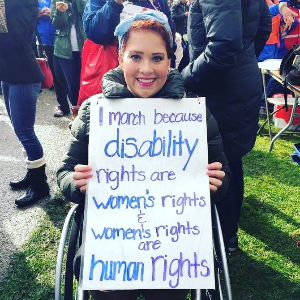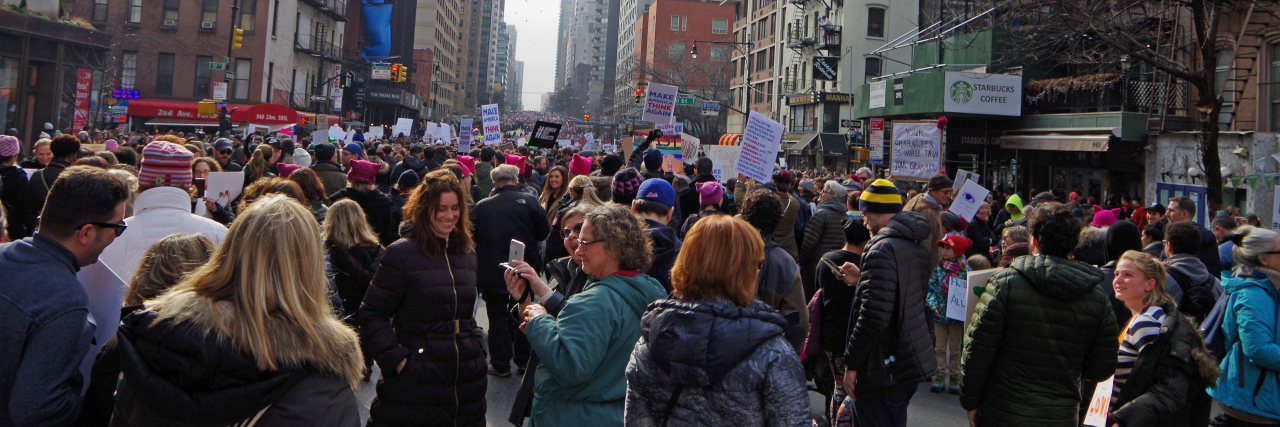On January 21, 2017, millions of people in cities across the United States and around the world organized and marched in reaction to the results of the 2016 Presidential election. Several prominent social movement groups were represented in these marches, as well as in the Women’s March on Washington’s official platform. One group was conspicuously absent, though: women with disabilities.
There were only two mentions of disability in the 2017 platform for the Women’s March, one of which directly implies that the needs of disabled women, and disabled people in general, are a “burden”:
“We recognize that women of color and Indigenous women carry the heaviest burden in the global and domestic economic landscape, particularly in the care economy. We further affirm that all care work — caring for the elderly, caring for the chronically ill, caring for children and supporting independence for people with disabilities–is work, and that the burden of care falls disproportionately on the shoulders of women, particularly women of color. We stand for the rights, dignity, and fair treatment of all unpaid and paid caregivers. We must repair and replace the systemic disparities that permeate caregiving at every level of society.”
Not only does this statement imply that disability is a burden which able-bodied women have disproportionately had to bear, but it ignores the intersectionality of disabled women. It ignores that disabled women are also caregivers. Motherhood, as well as the other forms of caregiving outlined in this passage, are not duties which are exclusively reserved for non-disabled women. The website and mission statement have been updated in anticipation of anniversary marches on Saturday, but this statement is still included verbatim.
The 2018 mission statement is improved slightly by the inclusion of this statement:

“We believe that all women’s issues are issues faced by women with disabilities and Deaf women. As mothers, sisters, daughters, and contributing members of this great nation, we seek to break barriers to access, inclusion, independence, and the full enjoyment of citizenship at home and around the world. We strive to be fully included in and contribute to all aspects of American life, economy, and culture.”
This is certainly a step in the right direction, but it is not enough. The last sentence of this statement is problematic to me. Maybe I am nitpicking, but to me, including the phrase “we strive to” sounds an awful lot like an offer of inclusion, as long as it’s not too hard or inconvenient for the rest of the movement. This is not how effective social movements need to operate. For far too long, disability rights as a social issue has been regarded as a “niche” issue. People neglect to recognize that the disabled community is not only the largest minority group in the world, but also the only one that anyone has the possibility to become a part of at some point in their life. Disability does not differentiate along the lines of race, sex, gender, socioeconomic status, sexual orientation, or any other identity group. It includes them all. Isn’t it about time all of those groups start including us too?
I had the opportunity to participate in a local Women’s March last year, and it was an incredible experience. As a wheelchair user, I sometimes feel intimidated and uneasy in large crowds of people. I tend to get lost below most people’s line of sight, which is a recipe for getting tripped over and occasionally elbowed in the face by mistake. Not only was the event exceptionally peaceful, but I also had the opportunity to talk to some amazing people. During much of the event, it was raining fairly hard and I was essentially left to the elements since I cannot carry an umbrella. I had the foresight to cover the sign I was carrying (attached around my neck with string like a big necklace) with plastic, but the rest of me was pretty soggy. Several kind strangers offered to walk with me and hold their umbrellas over my head as we marched. This was an extremely simple, yet powerful gesture that made me feel welcome.
An article written last year by Emily Ladau breaks down each bullet point in the official Women’s March platform and adds a note about how and why disability should be included in that section. The organizers do appear to recognize the importance of including disability in the platform, based on their response to her article, but why has much of the official language not changed from last year to now? Acknowledging the problem and fixing it are not the same.
To me, the best way to make this movement effective and inclusive is to simply show up. If you are able, attend whichever march, either local or national that suits your fancy. Get in there, hold a sign, represent yourself however feels most authentic to you, and don’t shy away from attention. If you are asked why it is important to you to be in attendance, make sure to highlight the conspicuous absence of disabled people, women especially, in social justice movements and why that needs to change. If you are planning to attend a Women’s March this year, offer rides to others who might like to attend but who don’t have transportation, or offer to make extra signs for people who are not able to make their own.
Of course, a major barrier to disabled participation in such movements is that many are simply not able to attend in person due to some aspect of their disability. If this is the case for you, consider submitting a statement to the online Disability March. In the age of social media addiction, “armchair activists” get such a bad rap, but you know what these people still are? Activists. If you are a disabled person who is anything like me, you may have been left with a feeling that the majority of this country does not care about “people like you” after this last presidential election. You may feel like you do not have a voice, or that your voice does not matter. I am here to tell you that your voice does matter, and all of our voices are stronger together than any of them are on their own.
We want to hear your story. Become a Mighty contributor here.
Getty image by Paul Pellegrino.

